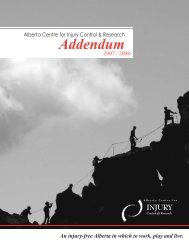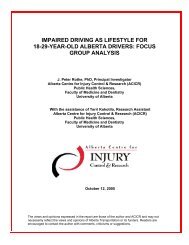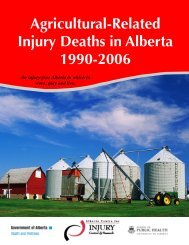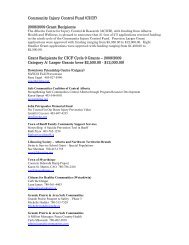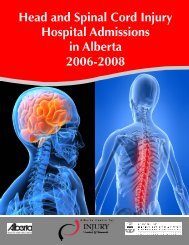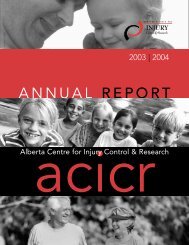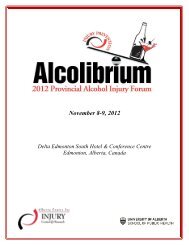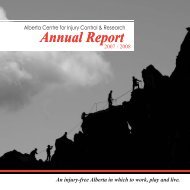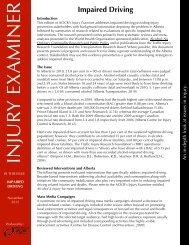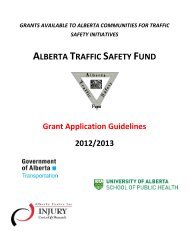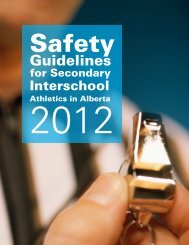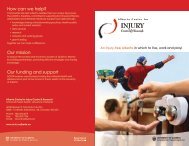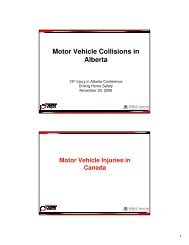JUNE 2003 - Alberta Centre for Injury Control & Research
JUNE 2003 - Alberta Centre for Injury Control & Research
JUNE 2003 - Alberta Centre for Injury Control & Research
You also want an ePaper? Increase the reach of your titles
YUMPU automatically turns print PDFs into web optimized ePapers that Google loves.
Challenge 6<br />
Limited research and program evaluation on the<br />
effectiveness of injury control interventions<br />
<strong>Injury</strong> control is a field that has attracted minimal research dollars. <strong>Research</strong><br />
is needed to build the body of knowledge surrounding the contributing<br />
factors, causes of injuries and the nature of the injury; assessing effectiveness<br />
of interventions, including product safety; and assessing improved<br />
approaches to collaboration. <strong>Research</strong> is also needed on the impact of the<br />
disabilities resulting from injuries.<br />
Knowledge transfer research is needed to convert the existing body of<br />
knowledge into viable and effective programs, services and interventions.<br />
Recognition of this important complement to basic and program evaluation<br />
research is needed to design and deliver rigorously developed programs as a<br />
critical part of the research agenda.<br />
Program evaluation is needed to assess what interventions are working or<br />
show promise and what interventions are not working and why. Personnel<br />
knowledge and skills in conducting effective evaluations need to be<br />
strengthened. The results of program evaluations need to be documented and<br />
shared among injury control practitioners <strong>for</strong> the benefit of all.<br />
Per<strong>for</strong>mance measures and targets, focusing on injury control outcomes, are<br />
also needed. <strong>Injury</strong> control initiatives need to identify expected results that<br />
can be measured. The results need to be continually monitored and evaluated<br />
in order to assess progress, make program changes and satisfy accountability<br />
requirements of the public, policy makers and funders.<br />
<strong>Research</strong> and<br />
program evaluation.<br />
SUMMARY<br />
In<strong>for</strong>mation on injuries clearly indicates that <strong>Alberta</strong> has a problem. The<br />
tragedy is that injuries are preventable. So why does <strong>Alberta</strong> have this<br />
problem? It could be any one or a combination of the challenges. Or it could<br />
be the attitude that people generally have towards injuries. When someone<br />
gets injured, they tend to accept the injury as one of those un<strong>for</strong>tunate events<br />
that can happen to anyone—it was an accident. The word accident implies<br />
something unplanned or un<strong>for</strong>eseen as though there was nothing anyone<br />
could do to prevent it. But evidence shows that is not the case. Data are<br />
available on what causes injuries and how to prevent them. In the case of<br />
intentional injuries, data are available on the barriers to seeking and<br />
obtaining help. Effective strategies are needed so that all the challenges<br />
become injury-reducing actions. Then injuries can be prevented and<br />
<strong>Alberta</strong>’s injury record can be changed.<br />
Making <strong>Alberta</strong> the Safest Place to Live<br />
29



